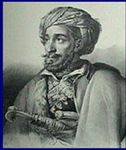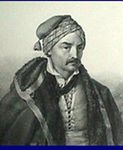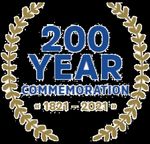Heroes of March 25th, 1821 - The Greek Independence Day
←
→
Page content transcription
If your browser does not render page correctly, please read the page content below
Heroes of March 25th, 1821 - The Greek Independence Day
On March 25, 1821 the bishop Germanos of Patras raised the Greek flag at the Monastery of Agia Lavra in Peloponnese
and that started the War of Independence against the Turks. The Greek War of Independence, also known as the Greek
Revolution, was a successful war waged by the Greeks between 1821 and 1827 to win independence from the Ottoman
Empire. The Greek War of Independence was a fiercely fought and destructive war against the Ottoman Empire for
independence, which started in 1821. The Greeks were the first of the subject peoples of the Ottoman Empire to secure
recognition as a sovereign power, a status which they achieved in 1832. The tree of freedom for the Greeks took a fair
amount of bravery and sacrifice for it to grow. Countless heroes, men and women, wrote their own history. Here we will
focus on some f them, who truly made a difference in so many ways! As we read their stories, let us motivate ourselves to
be worthy of heir sacrifice and to continue their legacy!
The great poet Rigas Feraios
Rigas Feraios wrote enthusiastic poems and books about Greek history and many became widely popular. One the most
famous (which he often sang in public) is the Thourio in which he wrote, "It's better to have an hour as a free man than
forty years as a slave." In Greek: «Ως πότε παλικάρια να ζούμε στα στενά…. Καλλιώναι μίας ώρας ελεύθερη ζωή παρά
σαράντα χρόνια σκλαβιά και φυλακή»… He urged Greeks to leave the Turkish-occupied towns for the mountains, where
they might experience more freedom.
Rigas went to Vienna (with its large Greek community) as part of an effort to ask Napoleon for assistance and support.
While in Vienna he edited a Greek-language newspaper, Ephemeris and created and published a proposed political map
of Great Greece which included Constantinople. He printed pamphlets based on the principles of the French Revolution,
including ("Declaration of the Rights of Man" and a "New Political Constitution of the Inhabitants of Rumeli, Asia Minor, the
Islands of the Aegean, and the principalities of Moldavia and Wallachia"). He intended to distribute them in an effort to
stimulate a Pan-Balkan uprising against the Ottomans.
While traveling to Venice in another attempt to meet Napoleon, Feraios was betrayed and was arrested at Trieste by the
Austrian authorities (allies of the Ottoman Turks, the Austrians were concerned the French Revolution might provoke similar
upheavals in Austria). He was handed over to the Ottoman Turkish governor at Belgrade where he was imprisoned and
tortured. From Belgrade, he was to be sent to Constantinople to be sentenced by the Turkish sultan. While in transit, he
was strangled on the night of 13 June 1798 to prevent his rescue by a sympathetic Ottoman Turk governor (Pasvanoglu).
His body was thrown into the Danube River. Rigas' death didn't end his influence on Greeks and other leaders finally led
the Greeks into revolution, beginning the Greek War of Independence in 1821.
Greeks tried many times to rebel – more than 20 actually. But all of the times they were not well trained or equipped to go
against the mighty Ottoman Empire. In one of the most important revolts, the Russian helped at the beginning and hope
started to mount. Yet, one more time, the Greeks were betrayed and at the end even more Greeks died at the hands of the
Turks.
His last words are reported as being: "I have sown a rich seed; the hour is coming when my country will reap its glorious
fruits".
Theodoros Kolokotronis (1770 - 1834)
He came from a family of kleftes and escaped to Zakynthos where he served in the English Army. He returned to
Peloponnesos on the eve of the revolution and due to his military experience and knowledge he soon became the leading
figure in organising the Greek fighters. He led the siege of Tripolis and its surrender marked the first success of the Greek
revolution. The following year (1822) with his courage, determination, patience, and military acumen defeated the army of
Dramalis. He was imprisoned by his political opponents but was freed when Ibrahim invaded Greece, against whom
Kolokotronis applied guerrilla tactics and was able to inflict major blows to his army. Kolokotronis is considered as the most
important figure of the Greek revolution.
HELLENIC AFFAIRS COMMITTEE | AHEPA YANKEE DISTRICT 7 | MARCH 2021Georgios Karaiskakis (1782 - 1827)
He grew up in poverty and was forced to the mountains as kleftis. He was one of the first to take part in the Greek revolution
and his military genius became apparent during the last years of the struggle. He was appointed by the first Greek
government as chief marshal of Eastern Greece and made Elefsina as his headquarters. Following a clash with the Turks
at Haidari, he was planning to cut off Kioutachis supplies, during the siege of Acropolis. His initial failures followed two
famous victories at Arachova and Distomo. He was killed in a clash with the Turks at Faliro. Karaiskakis is considered the
second most important military figure of the revolution, after Kolokotronis.
Konstantinos Kanaris (1793 - 1877)
He came from the island of Psara. He blew up the Turkish armada at Chios and at Tenedos and
other Turkish ships at Mytilene and Samos (1824). He attempted to burn the Turkish ships at the
port of Alexandria in order to destroy Mehmet Ali's preparations against Greece and failed only
due to the fact that at the time the wind was blowing from opposite direction. He became one of
the important naval figures of the revolution. With the liberation of Greece, he became involved
with politics opposing king Othon. He served several times as a minister and became prime
minister. He was brave, courageous, and modest man.
General Makriyannis (1797–1864)
He was born at Lidoriki, in Eastern Greece. When in June 1825, Ibrahim Pasha attacked the mills
of Argos with a force of 4,000 foot-soldiers and 600 cavalrymen from his regular army,
Mkriyannis, together with Ypsilantis, Mavromichalis and 300 men, defended the position, which
commands the approaches to Naples of Romania. They had already repulsed four fierce attacks
by Ibrahim when, towards evening, they were reinforced by a detachment of the first regular
Greek regiment. Its arrival decided the outcome of the battle and the Turko-Egyptian forces
retreated in great disarray, with heavy casualties. The gallant Makriyannis, who was gravely
wounded in the fighting, was invited aboard the French Admiral de Rigny's frigate, where he was
received by the admiral.
At the battle of Faliron on the 5th of February 1827, Makriyannis commanded the corps of
Athenians, under the orders of General Gordon. He distinguished himself again and again in the defense of his position, by
bravery in number of minor engagements.
Athanasios Diakos (1788-1821)
A Greek military commander during the Greek War of Independence, was born Athanasios Nikolaos Massavetas (Greek,
Αθανάσιος Νικόλαος Μασσαβέτας) in the village of Ano Mousounitsa, Phocis. Soon after the outbreak of hostilities, Diakos
and a local brigand captain and friend, Bousgos, led a contingent of fighters to capture the town of Livadeia. On 1 April
1821, after three days of vicious house-by-house fighting, and the burning of Mir Aga's residence, including the harem, the
town fell to the Greeks. Hursid Pasha sent two of his most competent commanders from Thessaly, Omer Vryonis and Kiose
Mehmet, at the head of 8,000 men with orders to put down the revolt in Roumeli and then proceed to the Peloponnese and
lift the siege at Tripolitsa.
Diakos and his band, reinforced by the fighters of Panourgias and Dyovouniotis, decided to halt the Ottoman advance into
Roumeli by taking defensive positions near Thermopylae. The Greek force of 1500 men was split into three sections.
Dyovouniotis was to defend the bridge at Gorgopotamos, Panourgias the heights of Halkomata, and Diakos the bridge at
Alamana.
Setting out from their camp at Lianokladi, near Lamia, the Ottoman Turks soon divided their force. The main force attacked
Diakos. The other attacked Dyovouniotis, whose force was quickly routed, and then Panourgias, whose men retreated when
he was wounded. The majority of the Greek force having fled, the Ottomans concentrated their attack on Diakos's position
at the Alamana bridge. Seeing that it was a matter of time before they were overrun by the enemy, Bousgos, who had
HELLENIC AFFAIRS COMMITTEE | AHEPA YANKEE DISTRICT 7 | MARCH 2021been fighting alongside Diakos, pleaded with him to retreat to safety. Diakos chose to stay and fight with 48 men; they put
up a desperate hand-to-hand struggle for a number of hours before being overwhelmed.
The severely wounded Diakos was taken before Vryonis, who offered to make him an officer in the Ottoman army if he
converted from Christianity to Islam. Diakos refused the offer. The next day he was impaled. His last words were... "I was
born a Greek; I Shall Die a Greek.
The brutal manner of Diakos's death at hands of the Turks ( Being roasted on a spit) initially struck fear into the population
of Roumeli, but his final stand near Thermopylae, echoing the heroic defence of the Spartan King Leonidas, made him a
martyr for the Greek cause. A monument now stands at the bridge near Alamana, the site of his final battle. His birthplace,
the village of Ano Mousounitsa, was later renamed Athanasios Diakos in his honor.
Manto Mavrogenous (1796 – 1848)
Amongst the heroines of the Greek revolution was Manto Mavrogenous. She was educated at a
college in Triestio and spoke Italian and Turkish. She studied ancient Greek philosophy and
history. In 1809 her family returned to Mykonos, the island of their origin. She learned with
excitement from her father that Philiki Etairia was preparing the Greek revolution. When the
news arrived that the struggle for freedom began, Manto invited the leaders of Mykonos to a
meeting and persuaded them to join the revolution. This was declared in April 1821.
Laskarina Boumboulina (1771 – 1825)
Yet another heroic woman of the Greek uprising for freedom. Boumboulina came from a rich
family from the island of Spetses. This 'Archontissa' (Lady) of Spetses used her wealth to build
a navy and became one of the most famous leading figures in the Greek War of Independence.
After the success of the revolution in Peloponnesos and Sterea Ellada, the uprising spread in
the islands. Spetses was the first of the islands to join the revolution and this was mainly due to
Boumboulina's leadership and courage. The example of Spetses was followed by many other
islands and therefore the freeing of the Island of Spetses was one of the initial major steps
towards victory for the Greeks. Thereafter Boumboulina, with her fleet took part in many naval
battles and dominated the Aegean creating problems to the, by far superior, Turkish fleet.
Nikitaras (1784 – 1849)
He was born at Leontari, in Arcadia, the son of a poor peasant farmer. He was a nephew of
Kolokotronis and he, too, served in the army of the Ionian Islands. In 1821 he became head of
a band of rebel fighters. He fought Kiaya Bey at Kaki Scala and in March and April 1822, at
Ayia Marina, Nikitas fought successfully under the leadership of Odysseus against Dramali,
who was threatening Thermopylae. After Dramali's invasion of the Morea, Nikitas took up a
position commanding the narrow passes on his route back to Corinth. There the Greeks
inflicted a terrible defeat on the enemy, killing 3,000 Turks. The result of this battle won for him
the nickname of Tourkophagos. At the siege of Mesolongi, Nikitas gave further proof of his
pure and selfless patriotism. The sailors bringing reinforcements to the besieged town
demeaned payment in advance. But there was no money. Then Nikitas flung down his sword,
a priceless weapon which he had won from a high-ranking Turk, and cried out, "All I have is
this sword. I offer it to my country!" His fine example had an immediate effect. All present
stepped forward eagerly to donate whatever they could afford.
HELLENIC AFFAIRS COMMITTEE | AHEPA YANKEE DISTRICT 7 | MARCH 2021Papaflesas or Gregorios Dikaios (1788 - 1825).
Papaflesas was born at Messinia in 1788. In his teens he became a monk. The Turks, knowing
his revolutionary character forced him to leave Greece. At Constantinople, where he went,
became one of the key members of "Filiki Etairia". Under Ypsilantis orders he returned to
Peloponnesos and started preaching the ideal of freedom, preparing so the people for the
revolution. He was a key figure of the Greek Revolution. When in 1825 Ibrahim landed with
thousands of Turkish army in Peloponnesos, Papaflesas leading 2000 men marched against
him. During the battle which took place at a place called Maniaki, on 20 May 1825, Ibrahim
with 6000 Turks attacked and killed 600 Greeks and their leader Papaflesas, who fought
bravely to the bitter end. At the end, Ibrahim said that if they were more Greeks like
Papaflessas, he would better turn back and leave Greece.
May their memory be everlasting! May we embrace their sacrifice with passion
and respect, and may God help all of us to be worthy to claim that we are their
descendants!
They were not just born of Greek blood – they proved it!
Hellenic Affiars District 7 Co-Chairmen,
Yiannis Apostolakis and George Rados PDG
Demetrius E. Tasoulas, Governor - District 7
HELLENIC AFFAIRS COMMITTEE | AHEPA YANKEE DISTRICT 7 | MARCH 2021You can also read
























































